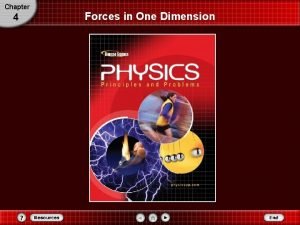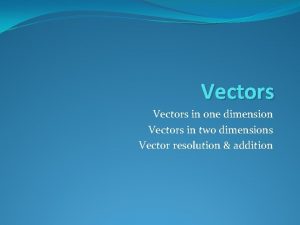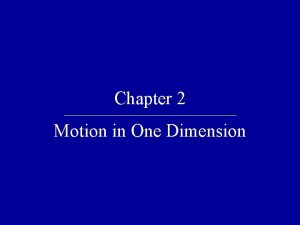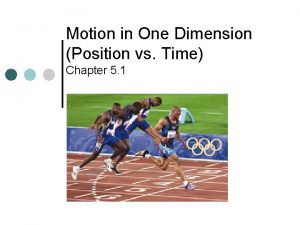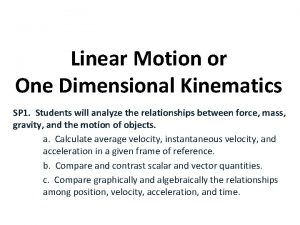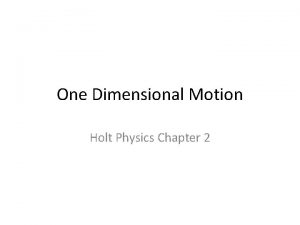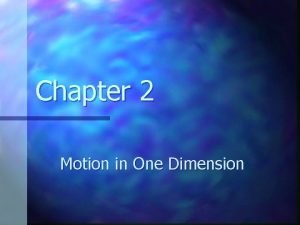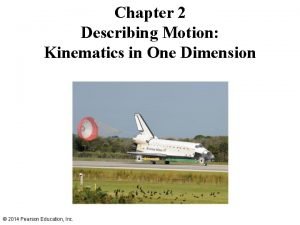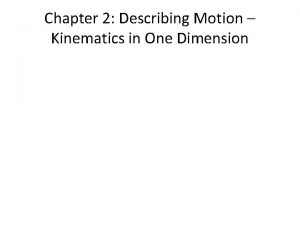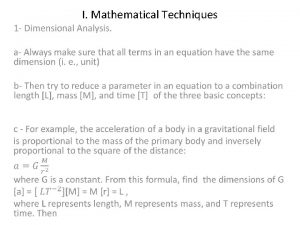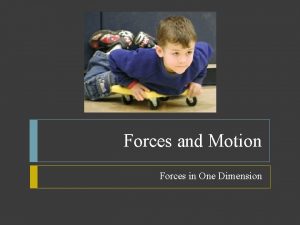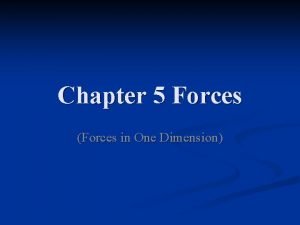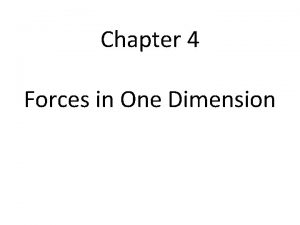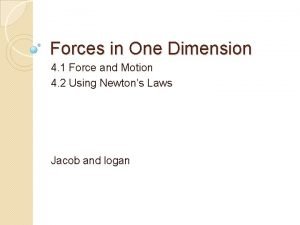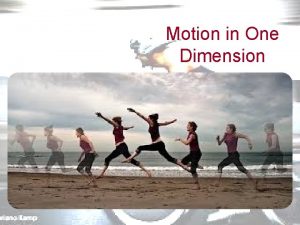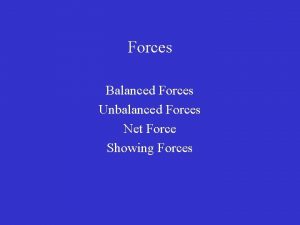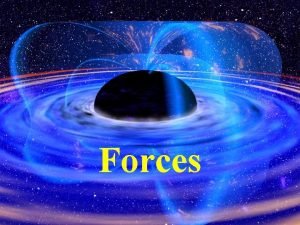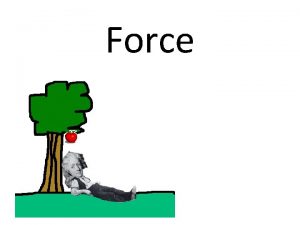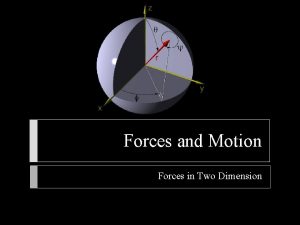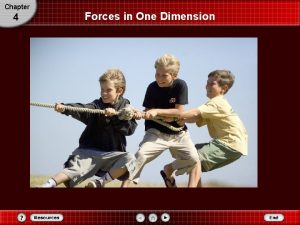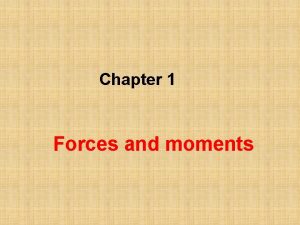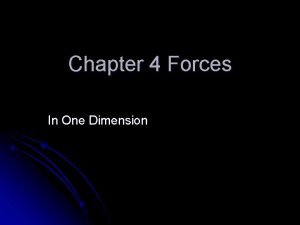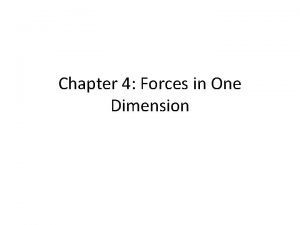Chapter 4 FORCES IN ONE DIMENSION Force and



































- Slides: 35

Chapter 4 FORCES IN ONE DIMENSION

Force and Motion

Contact Forces and Field Forces Contact forces are those in which have to touch the object to influence its motion Field forces, like Earth’s gravity, are those that are exerted without contact Forces result from interactions: The agent is the exerting force (hand pushing book) The system is the object acted up (book) ***If both don’t exist, then there is no force

Pop Quiz Cont. Traditionally, physicists agree that there a total of four fundamental forces in the universe: Can you name them? Need a hint, think of the four forces from chemistry…

From Motion Diagrams to Free -Body Diagrams Similar to all of the previous problems, drawing pictorial models (motion diagrams/FBD) will help analyze the forces in motion Identify all contact forces and field forces

Example of a Free-Body Diagram

Force Subscripts Gravity Fg or W Normal FN or N Tension FT or T Friction: Static Friction: Kinetic fs fk Applied Force Fapplied or Fapp

Newton’s First Law What is the motion of an object with no net force acting on it? Is it moving? Stationary? Neither? In the absence of a net force, the motion (or lack of motion) of both the moving object and the stationary object continues as it was. “An object that is at rest will remain at rest, and an object that is moving will continue to move in a straight line with constant speed, if and only if the net force acting on that object is zero”

Inertia & Equilibrium Newton’s First Law is sometimes called the Law of Inertia: the tendency of an object to resist change �If its at rest, it will want to remain at rest �If its moving, it will want to keep moving at the same speed �INERTIA IS BASED ON MASS ∴ More Mass = More Inertia Equilibrium SF = 0 This is the equation for equilibrium (equilibrium rule) and means this… �If all the forces added together equal zero, then the object is at equilibrium � Both objects at rest and those already in constant motion!!!


Combining Forces (Net Force) Net force is the sum of all force vectors present on an object SF = ? S is sigma and means “sum of all”

Newton’s Laws

Practice Problems 1. Two horizontal forces, 225 N and 165 N, are exerted on a 75 kg canoe. If these forces are applied in the same direction, find the net horizontal force on the canoe. a) Calculate the acceleration of the canoe. 2. Three confused sleigh dogs are trying to pull a sled across the Alaskan snow. Alutia pulls east with a force of 35 N, Seward also pulls east but with a force of 42 N, and big Kodiak pulls west with a force of 53 N. What is the net force on the sled?

Apparent Weight Gravity is based on acceleration rate but the Force of Gravity, or Weight, can change because its dependent on gravity (g) Thus when g changes, your weight will be altered �Examples would be different points on Earth, space, other celestial objects or even an elevator Apparent Weight: the force an object experiences as a result of all the forces acting on it, giving the object an acceleration If you were to fall without any contact forces pushing up, the object’s weight would be zero (apparent weight)… this is known as weightlessness

Interaction Forces always come in pairs An interaction pair is two forces that are in opposite directions and have equal magnitude Also referred to as action-reaction pair forces THEY MUST BE THE SAME TYPE OF FORCE Newton’s Third Law: “All forces come in pairs. The two forces in a pair act on different objects and are equal in strength and opposite in direction. ”

Newton’s Third Law Can you find all eight horizontal forces? Forces come in pairs and thus need to be labeled as such in freebody diagrams Ffoot A on ball Fball on foot A Ffoot C on ball Fball on foot C

Forces of Ropes and Strings Tension: specific name for the force exerted by a string, chain or rope Fg is pulling downward FT (tension from top of swing to bottom of branch) Tension is the same at all points in a rope

Normal Force Any time two objects are in contact, they are acting upon each other with forces Normal force is the perpendicular contact force exerted by a surface on another object It must be perpendicular to the plane of contact

Forces in Two Dimensions When a force is applied in more than one dimension, such as an angled force, incline plane, etc. , then components will be used to solve most problems Remember, Force is a vector and thus will need both a magnitude and a direction Forces can and will be negative depending on your choice of relative direction

Force & Motion in Two Dimensions Equilibrium Revisited When the net force on an object is zero, the object is in equilibrium and thus has no acceleration Equilibrant is the force that puts an object in equilibrium Similar to resultant but opposing direction (180° to it)

2 D Forces In almost all of these cases, the normal force FN will not be equal to the weight force Fg, or FW Remember normal force is not the reaction force to gravity Method for solving problems When using components, remember that cosine is for adjacent sides and sine is for opposite Look for the direction of motion Is it moving in only one direction (up/down or left/right) If it is, then the opposing dimension should be at equilibrium SF = 0 Substitution or system of equations will most likely be the method of solving problems!

2 D Force Let’s look at the pictures below: In this case, four forces are applied Which way is the box moving in the end? Calculate its resultant force vector. In this case, a force is applied downward and horizontally The box will remain on the ground but the FN > Fg Similar to a person pushing on the bathroom scale while you are standing on it Incline Plane In this problem, gravity is going to pull the box down but is it going straight down? Then will it feel the full effect of g?

Practice Problems Using the last two problems from the previous slide, lets calculate the acceleration of the boxes assuming the angles are both 37° and using our knowledge of Newton’s Three Laws Problem One Force = 20 N Theta = 37° Mass = 5 kg Problem Two

Drag Force & Terminal Velocity Air particles are all around us They exert a huge force but balanced because it is on all sides of us equally We have so far neglected the force of air on an moving objects but… �Drag Force: is the force exerted by a fluid (air or liquid) on the object moving through the fluid �The force is dependent on the motion of the object, the properties of the object and the properties of the fluid �Drag force increases with the speed of the object, is affected by size and shape of object and viscosity/temperature of fluid

Drag Force & Terminal Velocity When an object begins to free-fall, it has little velocity Thus, gravity is much stronger than the upward force of air (drag force) As the velocity increases, drag force increases as well �Eventually, drag force will be equal to force of gravity �At this point, net force is zero and thus no acceleration �Terminal Velocity

Chapter 4 - Section 4 FRICTION & EQUILIBRANT

Friction What is friction? Resistance to move one object relative to another. It acts in a direction opposite to the direction of motion. Friction is a force! What does friction depend upon? Properties of the two surfaces in contact The weight of the object being moved. Surface area in contact?

Types of Friction Static Friction The force exerted on one surface by another when there is no motion between the two surfaces Kinetic Friction Force exerted on one surface by another when the two surfaces rub against each other because one or both of them are moving

Frictional Force Equations fkinetic = mk. FN The kinetic friction force is equal to the product of the coefficient of the kinetic friction and the normal force fstatic < ms. FN The static friction force is less than or equal to the product of the coefficient of the static friction and the normal force ms. FN is the maximum static friction force that must be overcome to move f and FN are at right angles to each other

Frictional Force Equations The maximum static friction force is related to the normal force in a similar way as the kinetic friction force Remember that the static friction force acts in response to a force trying to cause a stationary object to start moving If there is no such force acting on an object, the static force is zero If there is a force trying to cause motion, the static friction force will increase up to a maximum value before it is over come and motion starts In other words, if the maximum static friction was 10 N, then the object will not move until a force > 10 N is applied. The moment the object begins to move, the total amount of frictional force is now only dependent on kinetic friction (which is always less than static)

Frictional Force The coefficient of friction, m, is a ratio and has no units Frictional Force is always opposing motion (180°) Perpendicular to normal force

2 D Force with Friction Let’s look at the pictures below: Calculate both static and kinetic friction for this box and determine if it is moving. F = 20. 0 N m = 1. 0 kg ms = 0. 20 & mk = 0. 11 q= 30° Calculate the frictional force. µ = 0. 15

Help Solving Incline Planes Motion along an inclined plane Start by identifying the forces acting on an object and then sketch a free-body diagram Fg would be the downward force FN would be perpendicular to the incline fk or fs is opposite to the motion vector Don’t forget to put your origin and coordinate system to identify positive direction **Most important decision in incline motion problems is your coordinate system The x-axis is usually positive in the direction of motion and the y-axis will be 90° to this or in the same direction as the FN vector Thus, the Fg is not opposite to the FN and vector resolution is required

Friction - Coefficient Lab Determining the Coefficient of Friction, µ Objective: Determine µ for an object on a 3 different surfaces. Materials: objects, 2 sturdy surfaces, balance, Newton scale Methods and Analysis 1. Sketch the setup showing the free-body diagram of the object being pulled at constant velocity by the Newton scale on the sturdy surface. 2. Determine the weight of the object. On a horizontal surface, weight equals FN. 3. Hook the scale to the object, then using a horizontal force, pull on the scale with a gradual increase in force until it starts moving along the sturdy surface at constant velocity. Record the approximate force on the scale to start the object and the force to maintain its constant velocity. 4. Calculate the μs and μk values for the surfaces using the equation for frictional forces. 5. Repeat for one other surface, then surmise the possible cause of frictional force differences. 6. Add to your object a 500 g or 1000 g mass, then determine μ s and μk for one surface and compare. 7. What applied force would be required to accelerate the blocks at 1. 5 m/s 2? What μ value did you use in this calculation of net force? 8. How is total friction reduced in (a) automobile engines (b) hovercraft. 9. How does increasing the angle of the incline affect the F N, μ, and the Ff?

Frictional Forces If you pull a block along a surface at a constant velocity, according Newton’s Laws, the frictional force must be equal and opposite to the force with which you pull Newton said if SF = 0, then at equilibrium and object is not accelerating e. g. Pull a block of known mass along a table at a constant velocity and use a spring scale Then additional mass to increase the normal force The slope of the kinetic frictional force vs. normal force will result in the mk or coefficient of kinetic friction f = m. FN or y = mx
 Chapter 4 forces in one dimension
Chapter 4 forces in one dimension Chapter 4: forces in one dimension answer key
Chapter 4: forces in one dimension answer key Vf-vo
Vf-vo Example of unlike parallel force
Example of unlike parallel force Contact force
Contact force Balanced forces and unbalanced forces venn diagram
Balanced forces and unbalanced forces venn diagram Constructive and destructive forces examples
Constructive and destructive forces examples Gstopwatch
Gstopwatch Structure of twelfth night
Structure of twelfth night Body diagram
Body diagram The forces shown above are pushing/pulling forces
The forces shown above are pushing/pulling forces Intermolecular vs intramolecular
Intermolecular vs intramolecular Difference between intermolecular and intramolecular
Difference between intermolecular and intramolecular Covalent bond intermolecular forces
Covalent bond intermolecular forces Vectors in two dimension
Vectors in two dimension Motion in one dimension quiz
Motion in one dimension quiz To describe a position in more than one dimension
To describe a position in more than one dimension Tape chart science
Tape chart science A common flea is recorded to have jumped
A common flea is recorded to have jumped Free fall motion in one dimension
Free fall motion in one dimension Define undefined terms
Define undefined terms What is dimensions in research
What is dimensions in research Motion in one dimension
Motion in one dimension Describing motion kinematics in one dimension
Describing motion kinematics in one dimension Describing motion kinematics in one dimension
Describing motion kinematics in one dimension Vy=vyo-gt
Vy=vyo-gt Mathematical techniques
Mathematical techniques One god one empire one religion
One god one empire one religion One one one little dogs run
One one one little dogs run One king one law one faith
One king one law one faith One god one empire one emperor
One god one empire one emperor One ford plan
One ford plan See one do one teach one
See one do one teach one See one, do one, teach one
See one, do one, teach one See one do one teach one
See one do one teach one Asean tourism strategic plan
Asean tourism strategic plan

